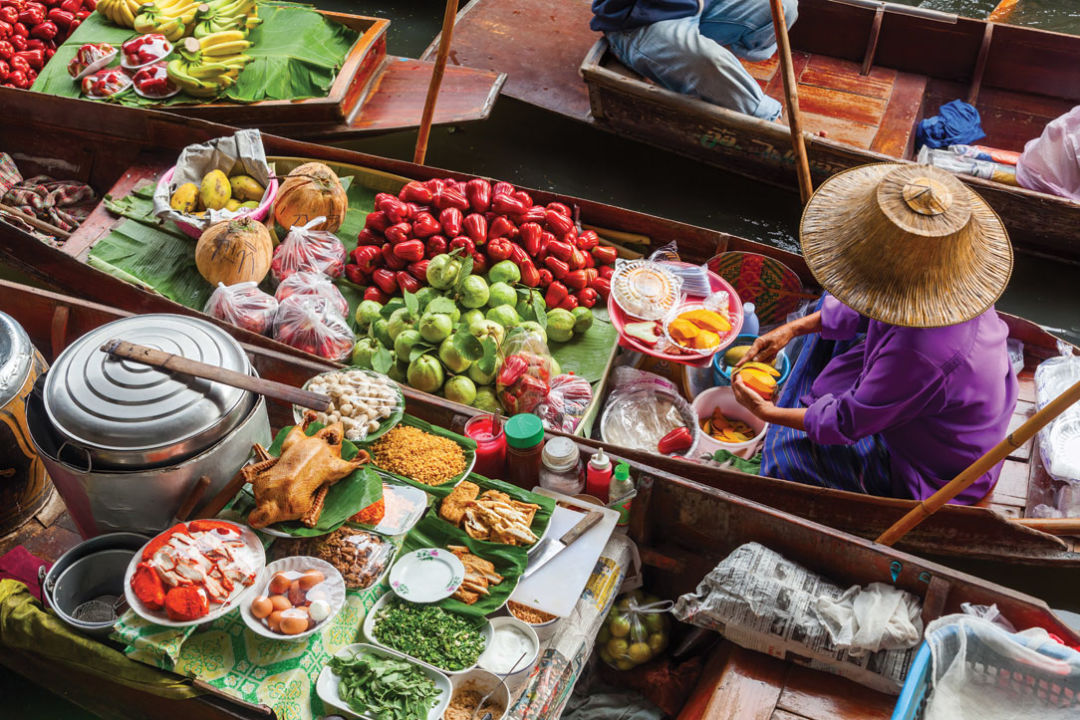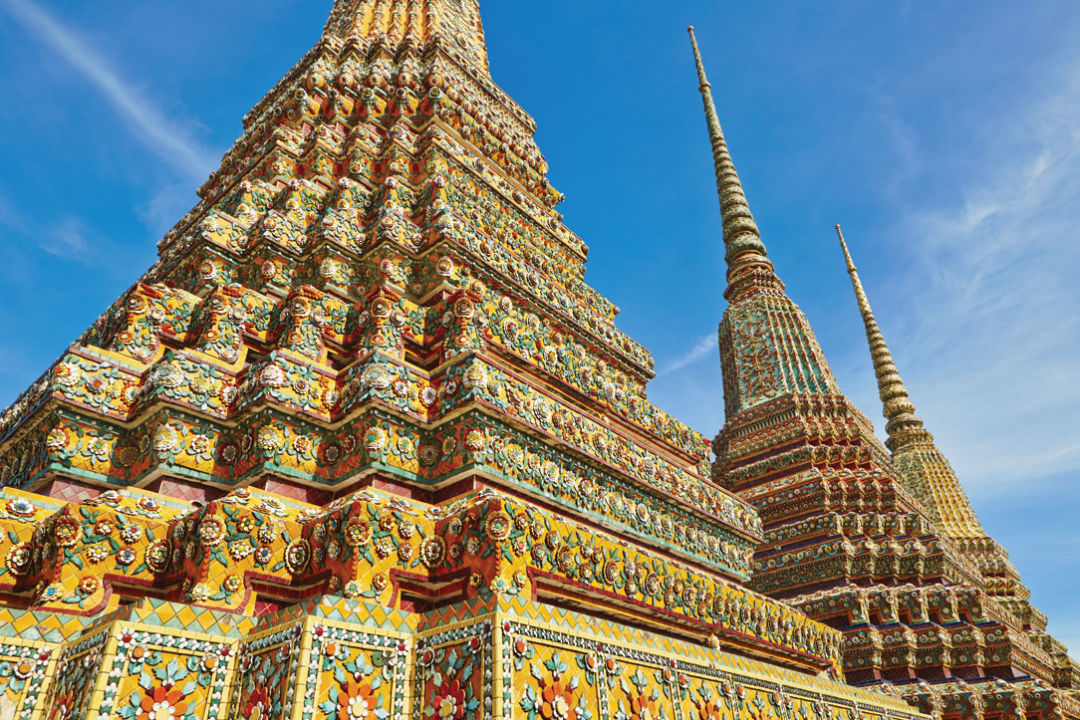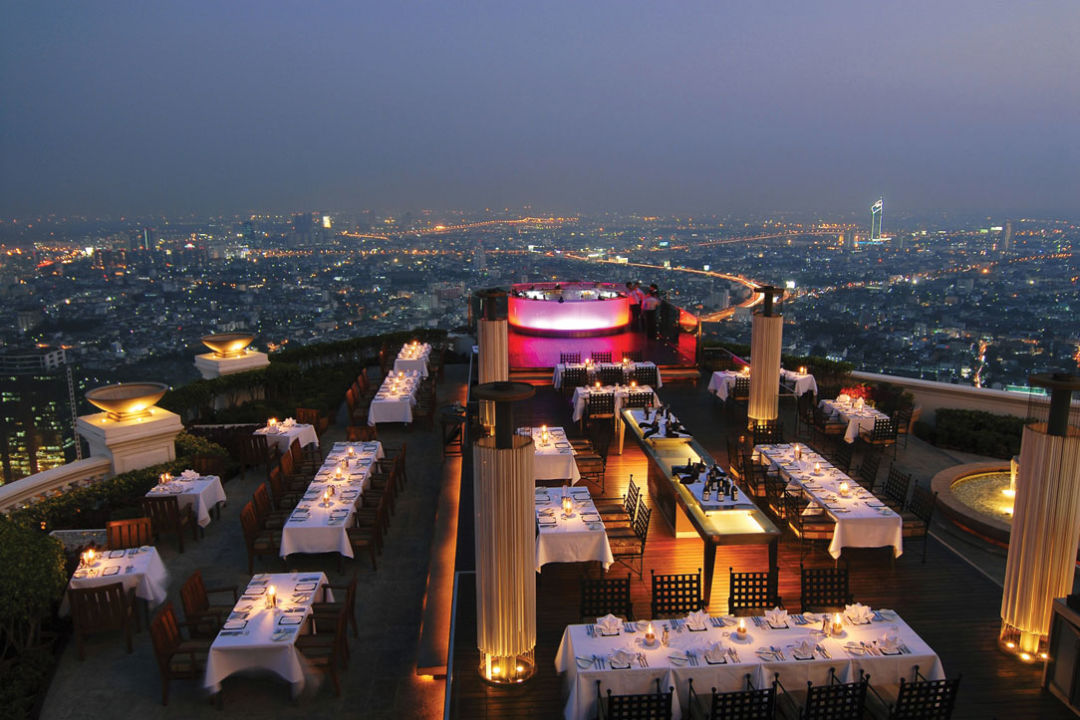Why Bangkok? The Shopping, the Food, and the Two-Dollar Foot Massages

Image: Shutterstock
"Why Bangkok?" friends asked when we mentioned our upcoming trip. We answered: the shopping, the food, and the two-dollar foot massages. I’d researched online for months and had a Pinterest board filled with pictures of the colorful Floating Market, the gorgeously ornate Grand Palace, and the sparkling Bangkok skyline. My husband and I flew to Thailand at the beginning of peak season, when the weather would be perfect for ambling the scenic streets and sampling wares from every smiling vendor. What we experienced, however, bore only a slight resemblance to the glamorous photos that had inspired the trip.
The taxi ride from Suvarnabhumi Airport to central Bangkok reminded me somewhat of driving through Houston. We zipped through suburbs we’d never visit despite their IKEA and their enormous mega marts. But then: Imagine you’re on I-45 passing over the McDonald’s on Main. Picture the buildings you’d see there, but make them twice as big, and fill the spaces with more buildings and 20-foot billboards advertising lipstick and face lightener. And change the McDonald’s to an open-air shack selling moped parts and lattes. Now stack that scene next to itself a hundred times, and you have downtown Bangkok.
We’d selected a five-star hotel on the bank of the Chao Phraya River. There were many, many such hotels in Bangkok at bargain prices—another reason we’d chosen to go there. Our hotel’s friendly staff let us check in early and called a cab to take us to the Chatuchak Weekend Market.

Wat Pho
Image: Shutterstock
Speeding through the inner city between mopeds for hire and hundreds of other cabs was no less overwhelming than the ride from the airport. We rode past dilapidated apartment buildings, luxury hotels, roadside shacks, 7-Elevens and government buildings stacked alongside each other without rhyme, reason, or zoning. The street outside our hotel featured a canal, a Honda dealership and two Buddhist temples. Everywhere, we saw giant, gold-trimmed, full-color images of the king. I understood, within the first few hours of our visit, why all the travel-advice sites warned against talking about the royal family for fear of breaking the law. It was difficult to avoid remarking on the king when his face followed us everywhere we went.
The Weekend Market, like most of the other markets we would see, was similarly visually discombobulating. Booths resembling tiny upscale boutiques and Etsy shops flanked others filled with dollar-store flotsam and Harwin-esque jewelry. There were multitudes of food stalls, and their most common offering was mini-wieners on sticks.
It took some time to find our first Bangkok meal. We passed dubious-looking outdoor kitchens with mismatched plastic seating (and not a few flies) before deciding on the setup that offered the most shade. We selected several dishes from the worn English-and-Thai menus, priced at the equivalent of two American dollars each. While we waited, we avoided looking too closely at our surroundings. I’ve eaten at the least-regulated flea markets on Airline Drive, but atmosphere-wise, those were a star above Bangkok’s outdoor eateries.
And yet we were served the most delicious Thai food we’d ever tasted. The tom yum soup held fresh galangal root, lemongrass and ginger and was garnished with a big, fat river prawn. Pork and garlic glistened on fresh rice noodles. We had a vegetarian curry with chopped wood ear and oyster mushrooms and deliciously seasoned morning glory greens.
We followed that revelation of a meal with our inaugural Bangkok foot massage, conducted in a plastic-curtain-shrouded booth. We sat very close to the other clients on auto seats covered with blankets and watched tiny Thai women squeeze our feet way too hard. We walked out bruised.
After that came the worst moments of our trip—dealing with the crooked cabbies the Internet had warned me about. The first driver zipped into the middle of the crowded street and announced he was taking us to a bargain jewelry store. We had to pay to make him stop. While online advice had assured me a few civilized words would be enough to extricate us from their clutches, the second driver pulled the same scheme and we ended up in a shouting match. We eventually found an honest cabbie several blocks away.
The next morning, jet lag woke us with renewed optimism at six a.m. We decided to walk to a nearby café, as Google Maps indicated there were plenty. Imagine the temperature and humidity of Houston in June, but without the easily available A/C, and you’re on that walk with us. Within a block, we were perspiring profusely, but forged ahead.
After several miles of walking and a cab ride to the tourist hub of Khao San Road, we had to break our cardinal rule of travel—no eating at chain restaurants we can visit at home—and picked up pastries at Starbucks. We didn’t find a local eatery willing to serve us until eleven.
Generally, we found there wasn’t much use leaving our hotel before noon. (In fact, for the multitudes of Muscovites camped at the pool, there was no reason to leave at all.) Many of the restaurants you see on maps don’t materialize until later in the day, when their owners roll out the carts and grills.
Once we understood that, the trip became much more fun. We began each of our remaining days by gorging ourselves at our hotel’s breakfast buffet. Then we spent hours photographing the tropical flowers and giant lizards on the hotel grounds before lunching with the locals. We visited the giant MBK mall, which offered the same merchandise we saw everywhere else, but also the magnificent Food Island. This floor-wide food court featured all kinds of cuisine, with a gorgeous variety of Asian desserts available for a fraction of what they’d cost on Bellaire Boulevard.
Another day, we went to an outdoor food-court-slash-market on Silom Soi 10, recommended by YouTube and frequented by banking-district workers. There were many tiny restaurants that didn’t show up on the map and didn’t even seem to have names, but were nonetheless incredible. These meals made my husband declare he could never eat Thai food at home again.
One afternoon, we took a cab to the city’s magnificent, 18th-century Grand Palace, only to be informed by armed guards that it was closed for the day. But Wat Pho, the nearby Buddhist compound built in the late 17th century, didn’t disappoint. We walked into each of its temples and regarded its many golden Buddhas and mosaicked walls. Even the crowds of other tourists didn’t detract from our wonderment at the structures’ centuries-old beauty.
In the evenings, we perused the most popular attractions. There was vibrant Chinatown, with its excellent outdoor seafood restaurants. Khao San Road offered cheap beer and an endless parade of grungy Australian backpackers. Patpong Night Market was disappointing, with its knock-off Polo shirts, determined ping-pong show promoters and bored bikini dancers. Asiatique, the Riverfront night market, was a relatively new attraction. It contained a maze of higher-end shops, restaurants aimed at tourists, and a family-friendly lady-boy theater. There was also a Ferris wheel and free ferry rides to many of the riverside hotels. We quickly learned to use Asiatique as a drop-off point for our cab rides, thus avoiding heavy bridge traffic.

Bangkok Resort
Image: Iebua Hotels/ Flickr
These successes emboldened us to try the massage parlors again. We opted for full-hour sessions at less than $10 each. The first loosened my ever-tense shoulders and immensely improved my life. The second hurt our backs like hell, so we cut our losses and went back to eating.
Despite the small disillusionments—jet lag made the nightlife impossible, and I didn’t find a single thing to buy (or anything in my size)—our trip was made memorable by the people. They call Thailand the Land of a Thousand Smiles, and that certainly described our hotel staff. But I preferred the innate kindness of those not paid to be nice to us, touched by the Bangkokians’ willingness to communicate with us using few or no words and to help us enjoy their city.
For example: I’d read horror stories about the Thais’ callous exploitation of animals and felt sad, at first, when I saw all the stray dogs and cats on the streets. But each one was treated as a community pet, constantly fed and very gently guided by the security officers tasked with chasing them from certain properties. One afternoon, I tried in vain to tempt a particularly photogenic cat toward my camera. A woman working at a nearby noodle stand stopped cooking and called to it in the proper Thai way (“Mee-OW”) so it would come running for a close-up.

Khao San Road
Image: Wasin Waeosri Flickr
There was the cab driver who drove us through several darkened streets on the way to Chinatown. Just when we’d decided our destination must be a very dreary place, he spun around the corner, shouted “Chinatown!” and surprised us with the best view of its neon lights.
And then there was the man who handed us a fingerbowl-bucket and responded to my thanks with an offhand “I love you.” While I understood he’d been taught the wrong phrase, I didn’t doubt that he felt at least a hearty, human affection.
Samuel Johnson noted, “The use of traveling is to regulate imagination with reality, and instead of thinking of how things may be, see them as they are.” Bangkok wasn’t at all what I expected, but I’m grateful to have traded my fantasies for the experience.




